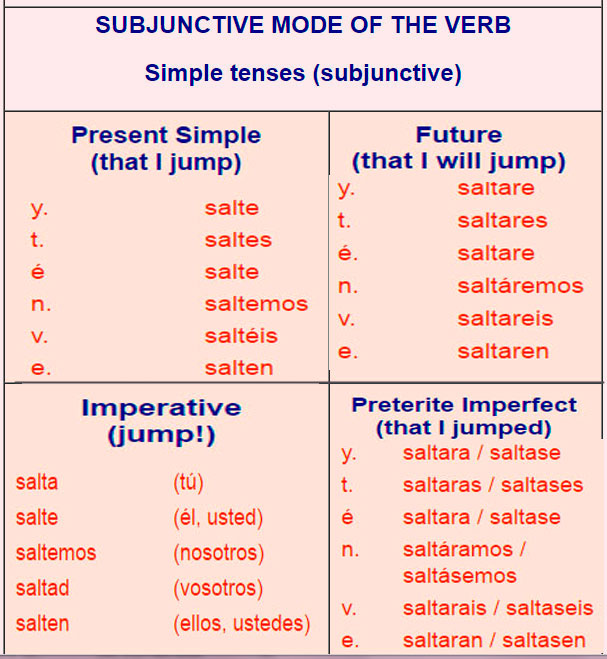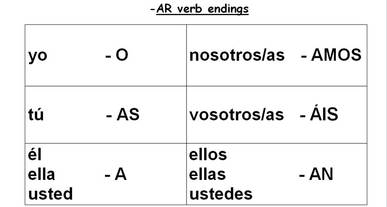
- #Ar verb endings in spanish how to#
- #Ar verb endings in spanish plus#
No comprenden el concepto – They don’t understand the concept. For example, the yo form for -AR, -ER, and -IR verbs is exactly the same. So even though these Spanish verbs have different endings, they shouldn’t be too difficult to remember.Ĭonjugating the -ER and -IR verbs is relatively easy in the present tense, especially since they are not too different from -AR verbs. In fact, the only difference is that for each of the regular verbs’ endings, you use the same pattern and replace all the A’s with E’s. Some verbs are irregular, meaning they have a stem change or don’t follow these rules the same way, but we’ll go over that another time… -ER ending verbsĪs you can see, Spanish verb conjugations with -ER ending verbs in the present tense are very similar to the -AR verbs’ conjugation patterns. So as you can see, as long as the -ar verb is regular, all you have to do is swap out the ending according to the subject. ¿Sacáis el postre? – Will you guys get out the dessert?. Llegamos tarde, ¿no? – We’ll get there late, won’t we?. Él no toma café – He doesn’t drink coffee. ❼aminas por el parque mucho? – Do you walk through the park a lot?. All we have to do is choose the proper ending that goes with the present tense form we want to use. We can then do that with any of the regular verbs that have an -ar ending. Then, we take the “ yo” (I) form and add the corresponding ending -o: So, for example, if I want to say “I speak,” we take the infinitive of the verb hablar and remove the -ar ending. In step two, we add a different ending depending on the personal pronoun we want to use. First, we look at the verb’s infinitive form, which is the version with the -ar ending. 
The present tense forms for -ar ending verbs are pretty simple to understand. Subject pronouns are pretty simple it can be a little confusing initially, but that’s because there are many regional variations, and sometimes they are used a little differently than in English.īut, now that you understand the pronouns and are familiar with their equivalents in English, we can move on to the verbs. So, as you can see, the Spanish grammar here really isn’t all that complicated.
Usted tiene el derecho de… – You have the right to …. It’s like saying, “you guys / you all / y’all.” It’s similar to English, where not everyone uses “sir/ma’am” in Spanish there are also regional differences.Īs an interesting Spanish fact, in the Americas, you can also use “ ustedes” to refer to a group of people in the second person, both formally and informally. This means that if you were talking to someone in a more formal context or to someone you need to show respect to, you would use usted (singular) and ustedes (plural). So in this sense, Spanish pronouns are more specific and give a little bit more information.įor usted and ustedes, these are referred to as the formal version of the second person. For example, in English, we can say “They ate dinner,” but in Spanish, “they” could be “ ellos / ellas,” depending on exactly who it was. #Ar verb endings in spanish plus#
Here is a list of all the different pronouns that we’ll use today:Īs you can see, there is an equivalent in Spanish for each of the English pronouns, plus some extras. In Spanish, it is very similar, but with some minor changes that we’ll see later on. In English, they are absolutely essential.įor example, in the sentence “I eat a sandwich,” “I” is the personal pronoun which tells you who is eating the sandwich.

These are called subject pronouns or personal pronouns because they tell you who the sentence’s subject is. Pronouns are words like I, you, he, she, etc. What Are Spanish Subject Pronounsīefore we get to the verbs, however, we have to first talk about the pronouns. So, in this article, we’re going to be going over everything you’ll need to know about the basics: Spanish regular verb conjugations in the present tense.

The Spanish verb conjugation is essential to the language, and the sooner you master it, the quicker you’ll start speaking like a native. There are specific rules and patterns when using Spanish verbs, and the changes you make to these verbs are called conjugation.
#Ar verb endings in spanish how to#
One of the first things you need to learn in any language is how to use verbs.







 0 kommentar(er)
0 kommentar(er)
